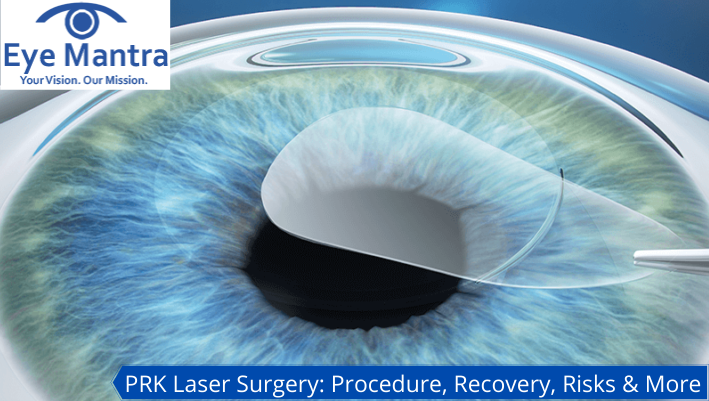
Contents
Photorefractive Keratectomy or PRK is a type of laser surgery to treat refractive errors. It is performed to correct vision problems. The refractive error is when your eye does not refract (bend) light properly.
There are several different surgical techniques used to reshape the cornea, the clear front part in the anatomy of the eye. All vision correction surgeries using laser, work on changing the contours of your cornea. This way the light traveling through it gets properly focused onto the retina located in the back of the eye. There are many different surgical techniques used to reshape the cornea.
PRK is used to treat myopia (nearsightedness), hyperopia (farsightedness), and astigmatism with laser surgery. PRK laser surgery is performed to correct your refractive error to improve your eyesight and vision. It is a kind of Specs Removal surgery, as it may reduce or even eliminate your need for eyeglasses or contact lenses.
With PRK laser surgery, your Eye Doctor uses a laser to change the shape of your cornea. This pulsing beam of ultraviolet light is used on the surface of the cornea, not underneath a corneal flap as in LASIK. The laser changes the shape of your cornea. This improves the way how light rays get focused on the retina. Light travels through the cornea and focuses on the retina at the back of your eye. On the other hand, LASIK, another type of laser surgery, works underneath your corneal flap.
If you suffer from Dry Eyes or thin corneas and want to have refractive surgery, PRK would be a good choice for you. This is because LASIK Surgery is not recommended because it can lead to dampening the cornea sensitivity and cause Dry Eye Syndrome.
Also, if you have a very active lifestyle or are working, PRK may be a better option for you than LASIK or other such procedures. The reason for this is that PRK laser surgery does not involve cutting a flap in your corneas like LASIK, and others. If you are highly active, the corneal flap could get accidentally dislodged, causing problems.
PRK laser surgery is not advised for certain patients who have:
PRK has enabled millions of people with myopia or hyperopia, by Specs Removal surgery, to achieve independence from eyeglasses or lenses. The procedure has low complication rates, and the result is quite predictable, i.e. treatment of low refractive errors.
Pachymetry is used to ascertain the thickness of your cornea. You and your Eye Doctor will discuss your needs based on your lifestyle. For example, if you are into sports, you may be looking for clear-distance vision from surgery. Therefore, it is important to discuss your expectations for PRK.
People who have PRK and expect to achieve perfect vision without glasses or contacts run the risk of being disappointed. PRK laser surgery allows people to do most of their everyday tasks without corrective lenses. However, you might need to wear glasses for some activities, such as reading or driving at night.
Your eye surgeon will thoroughly examine your eyes, and make sure you are the right candidate for PRK. Or your Eye Doctor would explain to you about other eye diseases that may keep you from having PRK.
Photorefractive Keratectomy (PRK laser Surgery process)
PRK surgery is usually performed in an outpatient surgery center. The procedure takes about 15 minutes, usually. Here is the process:
Right after surgery, a “bandage” contact lens will be placed over the eye to help it heal.
At first, you will experience Blurred Vision, after PRK. Over the next 3–5 days, as you heal, the vision will gradually improve. It, normally, takes a month or longer to achieve your best vision.
About 90% of people who have PRK end up with 6 by 6 vision or better without glasses or contact lenses.
It is important to know that PRK cannot correct Presbyopia. This is the normal, age-related loss of vision in seeing close objects. Almost everyone who has excellent distance vision will need reading glasses after around age 40, with or without refractive surgery.
To help with presbyopia, some people have PRK, first, to get monovision. In other words, one eye is left slightly nearsighted, and the other eye is adjusted for distance vision. Our brain modifies so that the nearsighted eye is used for close work, while the other eye sees distant objects. Monovision is not recommended for everyone. To see if you can adapt to this correction, you should ask to try monovision with contact lenses first.
Like all other surgeries, PRK carries risks of problems or complications you should consider. These include:
Also, your vision may end up being under-corrected or overcorrected. Most of these problems can be improved with glasses, contact lenses, or additional laser surgery.
And can be treated without any loss of vision. However, very rare problems may be:
If you are not uncomfortable with wearing contacts or glasses, you may not need refractive surgery. You and your ophthalmologist, together, can weigh the risks, and rewards of PRK.
It’s suggested to get your eyes treated with the best eye hospital in Delhi. It’s suggested to get your eyes treated with EyeMantra. PRK Laser surgery is not painful, and it just takes a few minutes. Still the procedure needs precision, experience, using the latest technologies, equipment, hygiene, and complete focus of the eye surgeon. Therefore, EyeMantra is recommended.
Call +91 9711115191. Now to book an appointment. Or mail at eyemantra1@gmail.com.
We also offer various services like Retina Surgery, Cataract Surgery, Glaucoma Surgery , and much more.